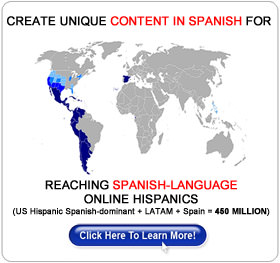Websites that cater to Hispanic American audiences are learning about the value of content marketing after a major Internet search giant shook up the world of online marketing forever.
For webmasters, publishers and Search Engine Optimization (SEO) professionals, things have not been the same since February 2011. That was the month when Google began to roll out Panda, a major update to its search algorithm. According to Google, the Panda update was specifically designed to cause a clampdown on Web spam, link farms, advertising-heavy websites, dubious backlinks, and other questionable SEO techniques that once gave Web pages a respectable rank on the Search Engine Results Page (SERP).
The immediate aftermath of Panda was not pretty. SEO professionals and online marketers have known about Google algorithm changes since the early days of the 21st century, but they had never before experienced something as drastic as Panda. According to Google’s engineers, the initial Panda update managed to affect 12 percent of global search results on English-language queries. Panda 2.0 and 2.1 rolled out a couple of months later, sending targeted websites far down the SERP.
As of November 2012, Google had rolled out more than 20 Panda updates in different languages. Penguin, the algorithmic change that followed Panda, also managed to lower the SERP of many websites and changed the rules of the game with regard to SEO.
Link Building After Panda
With Panda, Google changed the search marketing playing field in many respects. The SEO tenets of backlinks and keywords are still around, but the link building process has radically changed. In the past, SEO professionals would build a network of websites that would feature content related to their clients’ online properties. These networks served as placeholders for links leading back to clients looking for higher placement on the SERP. Panda and Penguin essentially rendered that SEO practice null.
SEO analysts do not believe that link building is dead, but Panda and Penguin have changed the nature of the practice. Links, instead of being created, must be earned in a way reminiscent of the early days of the Web when webmasters were happy to link to sites they considered interesting to themselves and their audiences. Inbound links must come from very high-authority websites, and this is where quality content marketing comes into play.
Content Marketing for Latino Audiences
Publishing quality content has always been relevant to the Web experience, but content marketing has turned into a practice that has a profound effect on the bottom line of businesses with online presences. Content marketing consists of creating and sharing quality items that are interesting, engaging and thus worthy of being shared across the Web and online social networks.
Although content usually refers to text articles, audio, picture and video files should also be considered part of a marketing strategy.
What content marketing means for Hispanic American audiences, is the creation of items that speak to the cultural sensibilities of Latinos in the United States. This means producing content that appeals to family life and cultural heritage; for example, writing articles that deal with current events of interest to different Hispanic American groups, including regional language terms in Spanish or Portuguese when applicable and featuring attractive photography.
If you’re interested in a need analysis to determine whether your biz can benefit from our services, contact Hispanic Market Advisors℠ at 1-844-HMA-FITS (462-3487) or by completing this online form: www.hispanicmarketadvisors.com/contact-us/




Leave a Reply